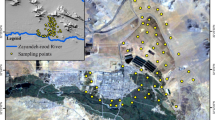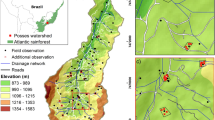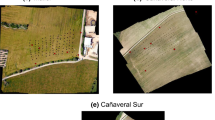Abstract
The presence of the petrogypsic horizon is an impediment to develo** agriculture in the Sahara. It hinders the soil’s ability to store water and root development of crops. The petrogypsic horizon is commonly difficult to map due to its location either on the surface or at depth. This study used logistic regression-kriging and logistic regression models to map the petrogypsic horizon occurrence probability using 466 observations over an area of 22 573 ha in the Sahara Desert of Algeria. The models included remote sensing indices and topographic variables as environmental covariates. The accuracy of models was verified by the area under the curve (AUC). A binary map was produced by applying a threshold of 0.7 on the most performant probability map. Our results showed that logistic regression-kriging performed the best (AUC = 0.88), due to the consideration of residual spatial correlation in the model. The grain size index covariate was the most relevant compared to topographic variables, which showed the usefulness of spectral indices. Based on the binary map, the risk associated with the presence of the petrogypsic horizon was limited, representing 26% of the study area. In the Sahara Desert, though the petrogypsic horizon was weakly correlated with the tested environmental covariates, the use of satellite images and residual autocorrelation in a predictive modelling approach improved the map** and thus risk assessment of the petrogypsic horizon.





Similar content being viewed by others
REFERENCES
S. Abdesselem and M. L. Timechbache, “Sur la nature de la croûte gypseuse dite “deb deb” dans les palmeraies de l’ouest des Ziban,” Alger. J. Arid Environ. 6 (1), 87–95 (2016).
M. E. Angelini and G. B. M. Heuvelink, “Including spatial correlation in structural equation modelling of soil properties,” Spat. Stat. 25, 35–51 (2018). https://doi.org/10.1016/j.spasta.2018.04.003
T. Assami and B. Hamdi-Aïssa, “Digital map** of soil classes in Algeria—a comparison of methods,” Geoderma Reg. 16, e00215 (2019). https://doi.org/10.1016/j.geodrs.2019.e00215
D. Badía, C. Martí, J. M. Aznar, and J. León, “Influence of slope and parent rock on soil genesis and classification in semiarid mountainous environments,” Geoderma 193, 13–21 (2013). https://doi.org/10.1016/j.geoderma.2012.10.020
D. E. Beaudette, R. A. Dahlgren, and A. T. O’Geen, “Terrain-shape indices for modeling soil moisture dynamics,” Soil Sci. Soc. Am. J. 77, 1696–1710 (2013). https://doi.org/10.2136/sssaj2013.02.0048
T. F. A. Bishop and A.B. McBratney, “A comparison of prediction methods for the creation of field-extent soil property maps,” Geoderma 103 (1–2), 149–160 (2001). https://doi.org/10.1016/S0016-7061(01)00074-X
J. G. Bockheim, “Gypsic and petrogypsic horizons,” in Soil Geography of the USA A Diagnostic-Horizon Approach, Ed. by J. G. Bockheim (Springer, Cham, 2014), pp. 179–188. https://doi.org/10.1007/978-3-319-06668-4_17
T. G. Boyadgiev and W. H. Verheye, “Contribution to a utilitarian classification of gypsiferous soil,” Geoderma 74 (3–4), 321–338 (1996). https://doi.org/10.1016/S0016-7061(96)00074-2
S. Casby-Horton, J. Herrero, and N.A. Rolong, “Gypsum soils-their morphology, classification, function, and landscapes,” in Advances in Agronomy, Ed. by L. D. Sparks (Elsevier, Amsterdam, 2015), Vol. 130, pp. 231–290. https://doi.org/10.1016/bs.agron.2014.10.002
C. Chagumaira, J. G. Chimungu, D. Gashu, P. C. Nalivata, M. R. Broadley, A. E. Milne, and R. M. Lark, “Communicating uncertainties in spatial predictions of grain micronutrient concentration,” Geosci. Commun. 4 (2), 245–265 (2021). https://doi.org/10.5194/gc-4-245-2021
F. Collard, B. Kempen, G. B. M. Heuvelink, N.P. A. Saby, A. C. Richer de Forges, S. Lehmann, P. Nehlig, and D. Arrouays, “Refining a reconnaissance soil map by calibrating regression models with data from the same map (Normandy, France),” Geoderma Reg. 1, 21–30 (2014). https://doi.org/10.1016/j.geodrs.2014.07.001
R. G. Congalton, “A review of assessing the accuracy of classifications of remotely sensed data,” Remote Sens. Environ. 37, 35–46 (1991). https://doi.org/10.1016/0034-4257(91)90048-B
O. Conrad, B. Bechtel, M. Bock, H. Dietrich, E. Fischer, L. Gerlitz, J. Wehberg, V. Wichmann, and J. Böhner, “System for automated Geoscientific analyses (SAGA) v. 2.1.4,” Geosci. Model Dev. 8, 1991–2007 (2015). https://doi.org/10.5194/gmd-8-1991-2015
A. E. K. Douaoui, H. Nicolas, and C. Walter, “Detecting salinity hazards within a semiarid context by means of combining soil and remote-sensing data,” Geoderma 13 (4), 217–230 (2006). https://doi.org/10.1016/j.geoderma.2005.10.009
H. Eswaran and G. Zi-Tong, “Properties, genesis, classification, and distribution of soils with gypsum,” in Occurrence, Characteristics, and Genesis of Carbonate, Gypsum, and Silica Accumulations in Soils, Ed. by W. D. Nettleton (Soil Sci. Soc. Am. Inc., Madison, 1991), pp. 89–119. https://doi.org/10.2136/sssaspecpub26.c6
D. M. Evans and A. E. Hartemink, “Digital soil map** of a red clay subsoil covered by loess,” Geoderma 230–231, 296–304 (2014). https://doi.org/10.1016/j.geoderma.2014.03.013
M. Faci and S. E. Benziouche, “Contribution to monitoring the influence of air temperature on some phenological stages of the date palm (cultivar ‘Deglet Nour’) in Biskra,” J. Saudi Soc. Agric. Sci. 20 (4), 248–256 (2021). https://doi.org/10.1016/j.jssas.2021.02.004
T. G. Farr, P. A. Rosen, E. Caro, R. Crippen, R. Duren, S. Hensley, M. Kobrick, M. Paller, E. Rodriguez, L. Roth, D. Seal, S. Shaffer, J. Shimada, J. Umland, M. Werner, M. Oskin, D. Burbank, and D. Alsdorf, “The shuttle radar topography mission,” Rev. Geophys. 45 (2), RG2004 (2007). https://doi.org/10.1029/2005RG000183
M. Fressard, Y. Thiery, and O. Maquaire, “Which data for quantitative landslide susceptibility map** at operational scale? Case study of the Pays d’Auge plateau hillslopes (Normandy, France),” Nat. Hazard Earth Syst. Sci. 14, 569–588 (2014). https://doi.org/10.5194/nhess-14-569-2014
G. Gastaldi, B. Minasny, and A. B. McBratney, “Map** the occurrence and thickness of soil horizons within soil profiles,” in Digital Soil Assessments and Beyond, Ed. by B. Minasny et al. (Taylor & Francis Group, London, 2012), pp. 145–148. https://doi.org/10.1201/b12728
S. Gengler and P. Bogaert, “Bayesian data fusion applied to soil drainage classes spatial map**,” Math. Geosci. 48, 79–88 (2016). https://doi.org/10.1007/s11004-015-9585-y
D. Goksuluk, S. Korkmaz, G. Zararsiz, and A. E. Karaağaoğlu, “easyROC: an interactive web-tool for ROC curve analysis using R language environment,” R J. 8 (2), 213–230 (2016).
R. Goossens and E. Van Ranst, “The use of remote sensing to map gypsiferous soils in the Ismailia Province (Egypt),” Geoderma 87 (1–2), 47–56 (1998). https://doi.org/10.1016/S0016-7061(98)00069-X
S. Grunwald, “Multi-criteria characterization of recent digital soil map** and modeling approaches,” Geoderma 152 (3–4), 195–207 (2009). https://doi.org/10.1016/j.geoderma.2009.06.003
T. Hengl, G. B. M. Heuvelink, and D. G. Rossiter, “About regression-kriging: from equations to case studies,” Comput. Geosci. 33 (10), 1301–1315 (2007). https://doi.org/10.1016/j.cageo.2007.05.001
T. Hengl, N. Toomanian, H. I. Reuter, and M. J. Malakouti, “Methods to interpolate soil categorical variables from profile observation: lessons from Iran,” Geoderma 140 (4), 417–427 (2007). https://doi.org/10.1016/j.geoderma.2007.04.022
T. Hengl, B. Kempen, G. B. M. Heuvelink, and B. Malone, Global Soil Information Facilities (GSIF), R Package Version 0.5–5 (ISRIC—World Soil Information, Wageningen, 2019). http://gsif.r-forge.r-project.org/.
J. Herrero, “Revisiting the definitions of gypsic and petrogypsic horizons in Soil Taxonomy and World Reference Base for Soil Resources,” Geoderma 120, 1–5 (2004). https://doi.org/10.1016/j.geoderma.2003.07.004
J. Herrero and R. E. Zartman, “Established soil science methods can benefit the construction industry when determining gypsum content,” Cleaner Eng. Technol. 4, 100154 (2021). https://doi.org/10.1016/j.clet.2021.100154
G. B. M. Heuvelink and R. Webster, “Spatial statistics and soil map**: a blossoming partnership under pressure,” Spat. Stat. 50, 100639 (2022). https://doi.org/10.1016/j.spasta.2022.100639
IUSS Working Group WRB, World Reference Base for Soil Resources 2014. Update 2015. International Soil Classification System for Naming Soils and Creating Legends for Soil Maps, World Soil Resources Report No. 106 (FAO, Rome, 2015). https://www.fao.org/3/i3794en/I3794en.pdf.
A. Jafari, P. A. Finke, J. Vande Wauw, S. Ayoubi, and H. Khademi, “Spatial prediction of USDA- great soil groups in the arid Zarand region, Iran: comparing logistic regression approaches to predict diagnostic horizons and soil types,” Eur. J. Soil Sci. 63, 284–298 (2012). https://doi.org/10.1111/j.1365-2389.2012.01425.x
H. Keskin and S. Grunwald, “Regression kriging as a workhorse in the digital soil mapper’s toolbox,” Geoderma 326, 22–41 (2018). https://doi.org/10.1016/j.geoderma.2018.04.004
J. Kim, C. Song, S. Lee, H-W. Jo, E. Park, H. Yu, S. Cha, J. An, Y. Son, A. Khamzina, and W-K. Lee, “Identifying potential vegetation establishment areas on the dried Aral Sea floor using satellite images,” Land Degrad. Dev. 31, 2749–2762 (2020). https://doi.org/10.1002/ldr.3642
T. V. Korolyuk and S. V. Ovechkin, “Approaches to modernization of the state soil map of Russia on the basis of the methods of digital soil map**,” Eurasian Soil Sci. 43, 488–498 (2010). https://doi.org/10.1134/S1064229310050029
M. H. Kouider, I. E. Nezli, and B. Hamdi-Aissa, “The use of spectral responses of surface in the discrimination of soils surface by remote sensing,” Energy Procedia 119, 622–631 (2017). https://doi.org/10.1016/j.egypro.2017.07.088
M. Kuhn, “Building predictive models in R using the caret package,” J. Stat. Software 28 (5), 1–26 (2008). https://doi.org/10.18637/jss.v028.i05
P. Lagacherie and A.B. McBratney, “Spatial soil information systems and spatial soil inference systems: perspectives for digital soil map**,” in Developments in Soil Science, Ed. by P. Lagacherie et al. (Elsevier, Amsterdam, 2006), Vol. 31, pp. 3–22. https://doi.org/10.1016/S0166-2481(06)31001-X
P. W. Lane, “Generalized linear models in soil science,” Eur. J. Soil Sci. 53, 241–251 (2002). https://doi.org/10.1046/j.1365-2389.2002.00440.x
B. Lemercier, P. Lagacherie, J. Amelin, J. Sauter, P. Pichelin, A. C. Richer-de-Forges, and D. Arrouays, “Multiscale evaluations of global, national and regional digital soil map** products in France,” Geoderma 425, (2022). https://doi.org/10.1016/j.geoderma.2022.116052
Y. P. Lin, B. Y. Cheng, H. J. Chu, T. K. Chang, and H. L. Yu, “Assessing how heavy metal pollution and human activity are related by using logistic regression and kriging methods,” Geoderma 163 (3–4), 275–282 (2011). https://doi.org/10.1016/j.geoderma.2011.05.004
J. Machín and A. Navas, “Spatial analysis of gypsiferous soils in the Zaragoza province (Spain), using GIS as an aid to conservation,” Geoderma 87 (1–2), 57–66 (1998). https://doi.org/10.1016/S0016-7061(98)00071-8
S. Manel, H. C. Williams, and S. Ormerod, “Evaluating presence–absence models in ecology: the need to account for prevalence,” J. Appl. Ecol. 38, 921–931 (2001). https://doi.org/10.1046/j.1365-2664.2001.00647.x
B.A. Marsman and J. J. de Gruijter, Quality of Soil Maps. A Comparison of Survey Methods in a Sandy Area, Soil Survey Papers, 15 (Netherlands Soil Survey Institute, Wageningen, 1986). https://edepot.wur.nl/ 302705
J. F. Martínez-Montoya, J. Herrero, and M. A. Casterad, “Map** categories of gypseous lands in Mexico and Spain using Landsat imagery,” J. Arid Environ. 74 (8), 978–986 (2010). https://doi.org/10.1016/j.jaridenv.2010.01.011
H. Midi, S. K. Sarka, and S. Rana, “Collinearity diagnostics of binary logistic regression model,” J. Interdiscip. Math. 13 (3), 253–267 (2010). https://doi.org/10.1080/09720502.2010.10700699
B. Minasny and A. B. McBratney, “Digital soil map**: a brief history and some lessons,” Geoderma 264, 301–311 (2016). https://doi.org/10.1016/j.geoderma.2015.07.017
I. D. Moore, R. B. Grayson, and A. R. Ladson, “Digital terrain modelling: a review of hydrological, geomorphological, and biological applications,” Hydrol. Processes 5, 3–30 (1991). https://doi.org/10.1002/hyp.3360050103
M. Neyestani, F. Sarmadian, A. Jafari, A. Keshavarzi, and A. Sharififar, “Digital map** of soil classes using spatial extrapolation with imbalanced data,” Geoderma Reg. 26, e00422 (2021). https://doi.org/10.1016/j.geodrs.2021.e00422
S. J. Nield, J. L. Boettinger, and R. D. Ramsey, “Digitally map** gypsic and natric soil areas using Landsat ETM data,” Soil Sci. Soc. Am. J. 71, 245–252 (2007). https://doi.org/10.2136/sssaj2006-0049
N. J. Perkins and E. F. Schisterman, “The inconsistency of “optimal” cutpoints obtained using two criteria based on the receiver operating characteristic curve,” Am. J. Epidemiol. 163, 670–675 (2006). https://doi.org/10.1093/aje/kwj063
A. C. Richer-de-Forges, N. P. A. Saby, V. L. Mulder, B. Laroche, and D. Arrouays, “Probability map** of iron pan presence in sandy podzols in South-West France, using digital soil map**,” Geoderma Reg. 9, 39–46 (2017). https://doi.org/10.1016/j.geodrs.2016.12.005
S. J. Riley, S. D. DeGloria, and R. Elliot, “A terrain ruggedness index that quantifies topo graphic heterogeneity,” Intermt. J. Sci. 5, 23–27 (1999).
RStudio Team, RStudio: Integrated Development for R, Version 1.1.453 (RStudio, Inc Boston, 2016).
I. Y. Savin and S. V. Ovechkin, “On the updating of medium-scale soil maps,” Eurasian Soil Sci. 47, 987–994 (2014). https://doi.org/10.1134/S1064229314100111
I. Y. Savin, A. V. Zhogolev, and E. Y. Prudnikova, “Modern trends and problems of soil map**,” Eurasian Soil Sci. 52, 471–480 (2019). https://doi.org/10.1134/S1064229319050107
E. F. Schisterman, D. Faraggi, B. Reiser, and J. Hu, “Youden Index and the optimal threshold for markers with mass at zero,” Stat. Med. 27, 297–315 (2008). https://doi.org/10.1002/sim.2993
P. A. Shary, “Environmental variables in predictive soil map**: a review,” Eurasian Soil Sci. 56, 247–259 (2023). https://doi.org/10.1134/S1064229322602384
C. Shepard, M. G. Schaap, J. Chorover, and C. Rasmussen, “Understanding critical zone evolution through predicting the three-dimensional soil chemical properties of a small forested catchment,” Soil Sci. Soc. Am. J. 82, 1538–1550 (2018). https://doi.org/10.2136/sssaj2018.03.0119
Soil Survey Staff, Soil Taxonomy. A Basic System of Soil Classification for Making and Interpreting Soil Surveys, Agriculture Handbook No. 436, 2nd Ed. (USDA–NRCS, Washington, DC, 1999).
L. Steinbuch, D. J. Brus, and G. B. M. Heuvelink, “Map** the probability of ripened subsoils using Bayesian logistic regression with informative priors,” Geoderma 316, 56–69 (2018). https://doi.org/10.1016/j.geoderma.2017.12.010
R. Taghizadeh-Mehrjardi, K. Schmidt, K. Eftekhari, T. Behrens, M. Jamshidi, N. Davatgar, N, Toomanian, and T. Scholten, “Synthetic resampling strategies and machine learning for digital soil map** in Iran,” Eur. J. Soil Sci. 71, 352–368 (2020). https://doi.org/10.1111/ejss.12893
W. H. Verheye and T. G. Boyadgiev, “Evaluating the land use potential of gypsiferous soils from field pedogenic characteristics,” Soil Use Manage. 13, 97–103 (1997). https://doi.org/10.1111/j.1475-2743.1997.tb00565.x
A. M. J.-C. Wadoux, B. Minasny, and A. B. McBratney, “Machine learning for digital soil map**: applications, challenges and suggested solutions,” Earth-Sci Rev. 210, 103359 (2020). https://doi.org/10.1016/j.earscirev.2020.103359
R. Webster and A.B. McBratney, “On the Akaike Information Criterion for choosing models for variograms of soil properties,” J. Soil Sci. 40, 493–496 (1989). https://doi.org/10.1111/j.1365-2389.1989.tb01291.x
J. **ao, Y. Shen, R. Tateishi, and W. Bayaer, “Development of topsoil grain size index for monitoring desertification in arid land using remote sensing,” Int J. Remote Sens. 27 (12), 2411–2422 (2006). https://doi.org/10.1080/01431160600554363
I. A. Yamnova and D. L. Golovanov, “Morphology and genesis of gypsum pedofeatures and their representation on detailed soil maps of arid regions,” Eurasian Soil Sci. 43, 848–857 (2010). https://doi.org/10.1134/S1064229310080028
X. Yang, A. K. Skidmore, D. R. Melick, Z. Zhou, and J. Xu, “Map** non-wood forest product (matsutake mushrooms) using logistic regression and a GIS expert system,” Ecol. Model. 198 (1–2), 208–218 (2006). https://doi.org/10.1016/j.ecolmodel.2006.04.011
Z. Zhang, “Variable selection with stepwise and best subset approaches,” Ann. Transl. Med. 4 (7), 1–6 (2016). https://doi.org/10.21037/atm.2016.03.35
G. Zhang, F. Liu, and X. Song, “Recent progress and future prospect of digital soil map**: A review,” J. Integr. Agric. 16 (12), 2871–2885 (2017). https://doi.org/10.1016/S2095-3119(17)61762-3
ACKNOWLEDGMENTS
The authors acknowledge the National Hydraulic Resources Agency (ANRH) for providing valuable documents related to the study area. Also, we are grateful to the local farmers who accompanied us in the field and provided valuable insights.
Funding
This work was supported by ongoing institutional funding. No additional grants to carry out or direct this particular research were obtained.
Author information
Authors and Affiliations
Corresponding author
Ethics declarations
ETHICS APPROVAL AND CONSENT TO PARTICIPATE
This work does not contain any studies involving human and animal subjects.
CONFLICT OF INTEREST
The authors of this work declare that they have no conflicts of interest.
Additional information
Publisher’s Note.
Pleiades Publishing remains neutral with regard to jurisdictional claims in published maps and institutional affiliations.
Rights and permissions
About this article
Cite this article
Assami, T., Chenchouni, H. & Hadj-Miloud, S. Map** the Petrogypsic Horizon Occurrence Probability in the Sahara Desert Using Predictive Models. Eurasian Soil Sc. 57, 551–561 (2024). https://doi.org/10.1134/S1064229323601920
Received:
Revised:
Accepted:
Published:
Issue Date:
DOI: https://doi.org/10.1134/S1064229323601920




